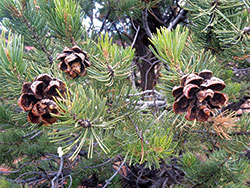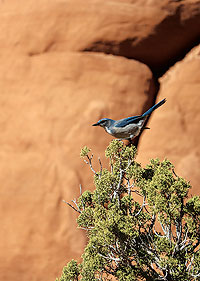 If you drive up into the La Sal Mountains outside of Moab or the Abajo Mountains which loom about Monticello, you will pass through forests with the stately, but small-statured, pinyon and juniper trees. Together, these trees define the pinyon-juniper woodlands, a habitat type found across millions of acres in the American Southwest. Better known as the “pygmy forest” or the “PJ,” these woodlands cover roughly 15 percent of the land in this region.
If you drive up into the La Sal Mountains outside of Moab or the Abajo Mountains which loom about Monticello, you will pass through forests with the stately, but small-statured, pinyon and juniper trees. Together, these trees define the pinyon-juniper woodlands, a habitat type found across millions of acres in the American Southwest. Better known as the “pygmy forest” or the “PJ,” these woodlands cover roughly 15 percent of the land in this region.
These woodlands occur between roughly 4,500 and 7,500 feet (1,370 to 2,290 meters) and represent the transition from lower elevation shrublands and grasslands to the higher elevation forests dominated by ponderosa pine. Through studies of pack rat middens, cores from lake sediments or dry caves, and archaeological sites, scientists have determined that by the end of the last ice age, the Wisconsin glaciation which lasted roughly between 100,000 to 11,000 years ago, the pinyon-juniper woodland extended more to the south and at lower elevations. Climate change, in terms of warming temperatures and less precipitation, resulted in a shift of the PJ range northward and upward in elevation.
 Today, throughout the PJ range, various species of pinyon and juniper occur. In southeastern Utah, the Colorado pinyon or two-needle pinyon pine (Pinus edulis) and Utah juniper (Juniperus utahensis) represent this forest type. Farther west into Nevada and California, the single-leaf pinyon (P. monophylla) replaces the two-needled pinyon. In parts of the region, the Rocky Mountain juniper (Juniperus scopulorum) and one-seed juniper (J. monosperma) replace utahensis.
Today, throughout the PJ range, various species of pinyon and juniper occur. In southeastern Utah, the Colorado pinyon or two-needle pinyon pine (Pinus edulis) and Utah juniper (Juniperus utahensis) represent this forest type. Farther west into Nevada and California, the single-leaf pinyon (P. monophylla) replaces the two-needled pinyon. In parts of the region, the Rocky Mountain juniper (Juniperus scopulorum) and one-seed juniper (J. monosperma) replace utahensis.

In Canyon Country, the PJ woodland is well represented with twisting trunks of Utah junipers and the seemingly impossible existence of pinyons growing out of thin cracks in the sandstone. The trees and other plants associated with these woodlands support a wide variety of wildlife such as mule deer, pinyon jays, Clark’s nutcrackers, elk, and porcupines whose nocturnal gnawing on the pinyon bark often leads to the death of the tree. And in this arid landscape, where decay takes place slowly, these snags may remain standing for many years in defiance of the conditions.
The early Native Americans, the Archaic people, and the Ancestral Puebloans, that lived in the Four Corners region utilized the vegetation in the PJ woodland for food, medicine, building materials, and more. During “mast” years when the pinyons produce abundant seeds, these were harvested and stored in baskets and pots. Good tasting, the seeds are also rich in proteins and beneficial minerals.
Other plants growing in the PJ woodlands include Indian ricegrass, Gambel’s oak, Fremont mahonia, Utah serviceberry, big sagebrush, Colorado four-o’clock, butterfly weed, and many other plants. One note here is that the name “cedar” is often used in place of the name “juniper,” since both trees have scale-like leaves. Early pioneers misidentified the trees as cedars; however, the name stuck. In addition, Spanish explorers in the region in the 1600s called the trees pino piñonero which has been modified to the modern-day piñon.
As you hike trails through the PJ, notice the lack of crowding between plants. In this land of little rain, plants tend to be spaced apart. The lack of moisture and the dominance of the landscape’s geology limits the growing conditions. Historically, this spacing resulted in single tree fires after a lightning strike, instead of vast acreages burned.
Though the PJ woodland may seem stunted in height to those who expect their forests to bear tall trees, these pygmy forests enable one to see the forest through the trees, bringing into focus the interplay between weather and vegetation, with a side serving of fascinating wildlife and human history.